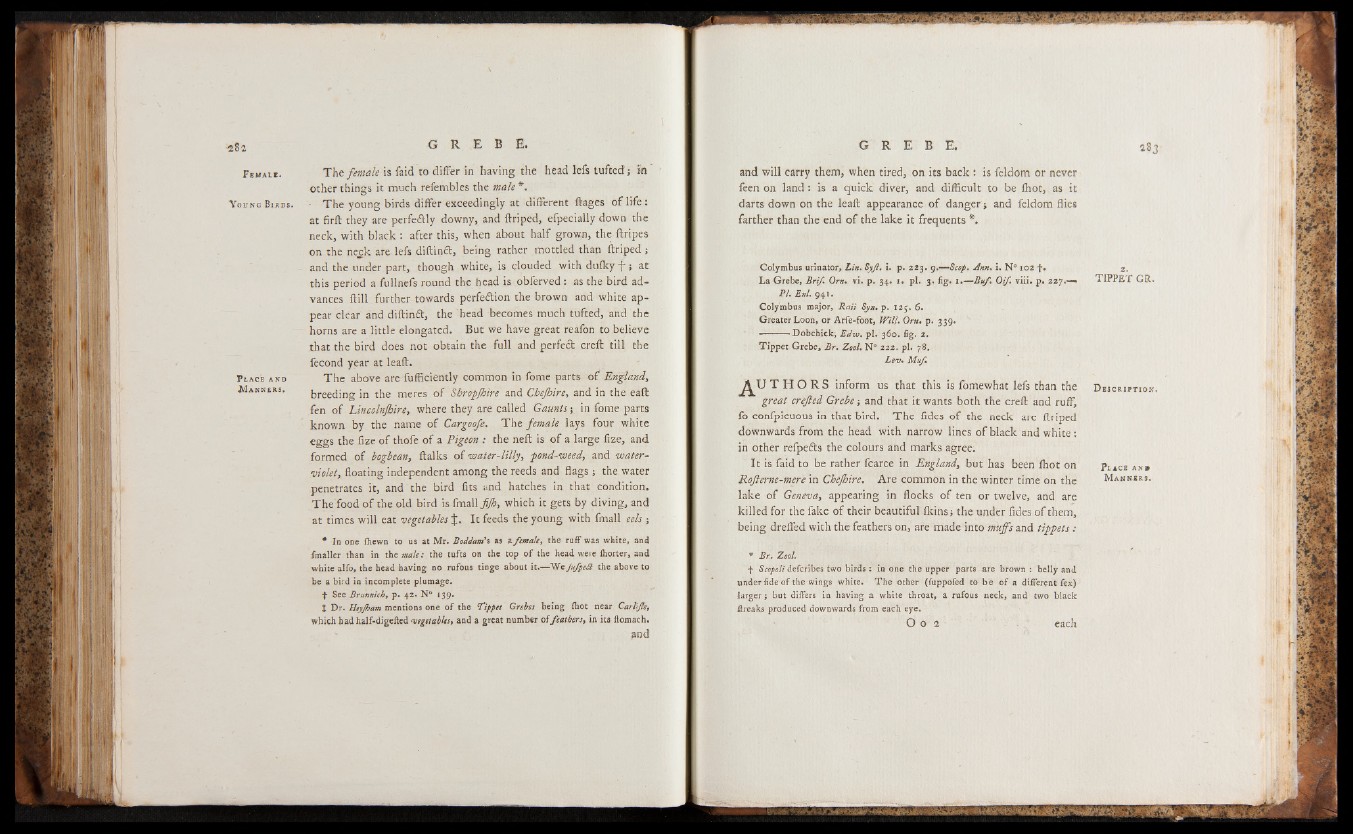
The female is faid to differ in having the head iefs tufted; in
other things it much refembles the male *.
The young birds differ exceedingly at different ftages of life:
at firft they are perfeftly downy, and ftriped, efpecially down the
neck, with black : after this, when about half grown, the ftripes
on the neck are lefs diftinft, being rather mottled than ftriped j
and the under part, though white, is, clouded w ith d u fk y f; at
this period a fullnefs round the head is obferved : as the bird advances
ftill further towards perfe&ion the brown and white appear
clear and diftinft, the head becomes much tufted, and the
horns are a little elongated. But we have great reafon to believe
that the bird does not obtain the full and perfeft creft till the
fecond year at leaft.
The above are fufficiently common in fome parts o f England,
breeding in the meres of Shropjhire and Chejhire, and in the eaft
fen of Lincolnjhire, where they are called Gaunts-, in fome parts
known by the name of Cargoqfe. The female lays four white
eggs the fize of thofe of a Pigeon : the neft is of a large fize, and
formed of bogbean, ftalks of water-lilly, pond-weed, and water-
violet, floating independent among the reeds and flags ; the water
penetrates it, and the bird fits and hatches in that condition.
The food of the old bird is fmall fijh, which it gets by diving, and
at times will eat vegetables %. It feeds the young with fmall eels\
* In one ihewn to us at Mr. Boddam'e as a female, the ruff was white, and
Imaller than in Usee male: the tufts on the top of the head were fliorter, and
white alfo, the head having no rufous tinge about it.—Vfejufpea the above to
be a bird in incomplete plumage.
■ f See Brunnich, p. 42. N" 139,
t Dr. Heyjham mentions one of the fippet Grebes being ihot near CarliJKr,
which had half-digefted •vegetables, and a great number offeathers, in its ftomach.
and
and will carry them, when tired, on its back : is feldom or never
feen on land : is a quick diver, and difficult to be fhot, as it
darts down on the leaft appearance of danger; and feldom flies
farther than the end of the lake it frequents *.
Colymbus urinator, Lin. Syji. i. p. 223. g.— Scop* Ann. i. N° 102 f . 2.
La Grebe, Brif* Orn. vi. p. 34. 1. pi. 3. fig. i*— Buf. Oif. viii. p. 227.—* TIPPET GR.
PI. Enl. 941.
Colymbus major, Rati Syn* p. 123. 6.
Greater Loon, or Arfe-foot, WilJ. Orn. p. 339. N
...........Dobchick, Edw. pi.'360. fig. 2.
Tippet Grebe, Br. Zool, N° 222. pi. 78.
Lev* Mu/*
AUT Id O R S inform us that this is fomewhat lefs than the D e s c r i p t io n ,
great crefted Grebe j and that it wants both the creft and ruff,
fo confpicuous in that bird. The Tides of the neck are ftriped
downwards from the head with narrow lines of black and white :
in other refpects the colours and marks agree.
It is faid to be rather fcarce in England, but has been fhot on Place an.
Rofterne-mere \n Chejhire. Are common in the winter time on the M anne r s .
lake of Geneva, appearing in flocks of ten or twelve, and are
killed for the fake of their beautiful (kins j the under fides of them,
being dreffed with the feathers on, are made into muffs and tippets:
* Br.» Zoo.i.
4* Scopoli deferibes two birds : in one the upper parts are brown : belly and
under fide of the wings white. The other (fuppofed to be of a different fex)
larger; but difFers in having a white throat, a rufous neck, and two black
breaks produced downwards from each eye.
O o a each
Wi
IM